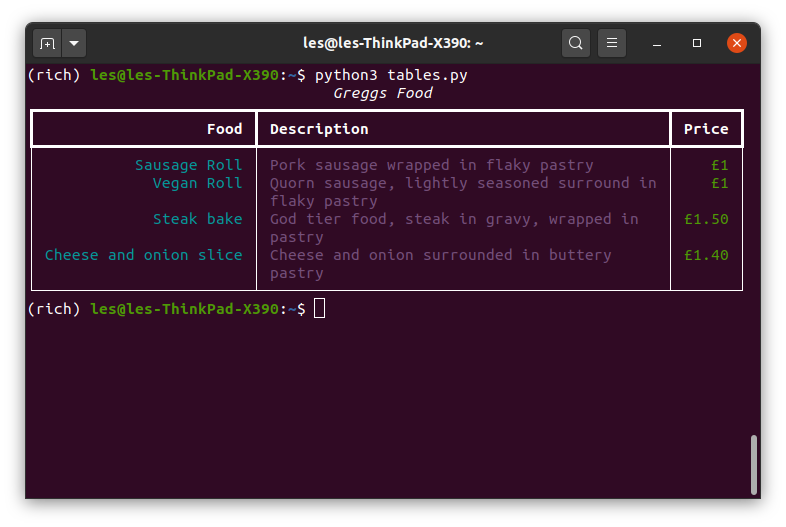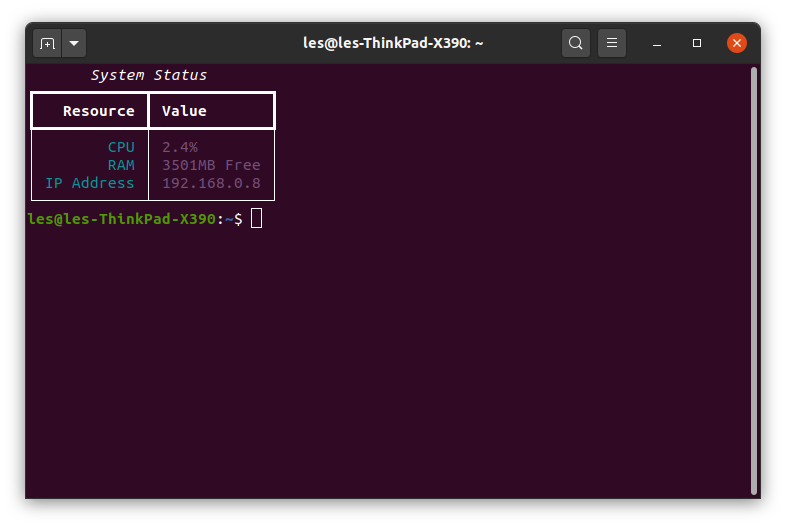Tuesday Tooling: That's Rich!
The Python REPL is useful, but now we can make it beautiful.
So What s it?
Rich is a Python library for writing rich text (with color and style) to the terminal, and for displaying advanced content such as tables, markdown, and syntax highlighted code. - Rich Website
Created by Will McGugan Rich is a simple Python module which we can use to add a little simple beauty to our scripts.
So How Do I Install It?
Using pip of course!
Linux
sudo pip3 install rich
Windows
pip3.exe install rich
So What Can I Do With It?
Create colourful output

Custom Prompts To Capture User Input

from rich.text import Text
from rich.console import Console
from rich.prompt import Prompt
console = Console()
name = Prompt.ask("Enter your name", choices=["Les", "Dexter", "Paula"], default="Les")
if name == "Les":
text = Text("@biglesp woz ere")
text.stylize("bold red", 0, 8)
text.stylize("bold green", 8, 12)
text.stylize("bold blue", 12,16)
console.print(text)
else:
text = Text("Who are you?!")
text.stylize("bold red", 0, 13)
console.print(text)
Create a table

Create a panel to highlight information

from rich import print
from rich.panel import Panel
print(Panel("[red]RED ALERT!", title="ALERT STATUS"))
And there are lots more things that you can do!
Make Something Cool!

Using an old blog post on psutil, I made a quick status app that provides me with the current CPU utilisation, available RAM and my IP address.
First I imported psutil and then the Console and Table classes from the rich module.
import psutil
from rich.console import Console
from rich.table import Table
I then create a link to use the Console() function.
console = Console()
I create a variable to hold the current CPU usage.
cpu = psutil.cpu_percent(interval=1)
I then create a variable memory which initially contains all of the data dumped from the command. I then pull the data that I want, and convert it to Megabytes.
memory = psutil.virtual_memory()
memory = memory[1]
memory = round(memory / 1024 / 1024)
To get my IP address, I need to know my Interface name, and then pull the data for that interface.
interfaces = psutil.net_if_addrs()
ip = interfaces["wlp0s20f3"][0][1]
On to the rich specific bit now. To create a table, we need to give it a title.
table = Table(title="System Status")
Now I add two columns, the first is called Resource and the second is Value. They contain the name of the resource and the value it reports. I also add a little colour to the table.
table.add_column("Resource", justify="right", style="cyan", no_wrap=True)
table.add_column("Value", style="magenta")
The three rows of the table are my CPU, RAM and IP address.
table.add_row("CPU", str(cpu)+"%")
table.add_row("RAM", str(memory)+"MB Free")
table.add_row("IP Address", str(ip))
I then display the table to the REPL.
console.print(table)
Save and run the code to see your own table full of the data that you need.

I saved my project as an executable file and launch it whenever I start a new BASH terminal.